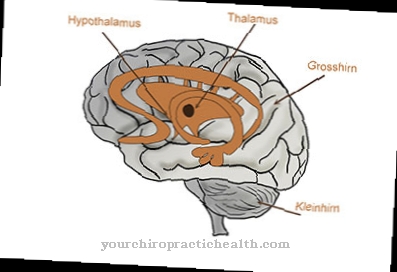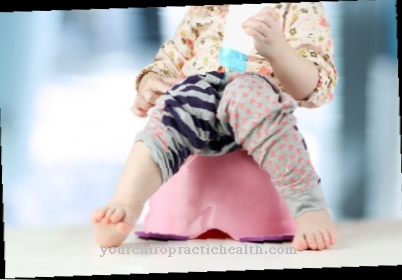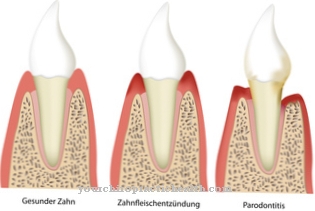At a Esophageal diverticulum it is an outward bulging of the esophagus. They are divided into three groups. The following describes the clinical picture and course as well as diagnosis, treatment and prevention.
What is an esophageal diverticulum?
.jpg)
Esophageal diverticulum are a rather rare disease. Mostly older men are affected. This leads to an outward protuberance of the esophageal wall.
Esophagus comes from the Greek and means "the food-bring" and thus stands for the esophagus. Diverticulum comes from Latin and means absenteeism or deviation. A distinction is made between "false" and "real" diverticula in this clinical picture.
If only a prolapse of the mucous membrane develops, if only the mucous membrane turns outwards, this is called a false diverticulum. If, on the other hand, all layers of the esophageal wall are affected by the protuberance, doctors refer to this as a real diverticulum. Diverticula are localized and can vary in size. They arise at the physiological constrictions of the esophagus, thus in the upper, middle and lower third.
causes
Esophageal diverticulum can occur in the course of life or are congenital.They develop through increased pressure in the hollow organ or through the action of tensile force from outside, which causes the tissue to give way and a diverticulum can develop.
A distinction is made between pulse diverticula and traction diverticulum. Pulse diverticula are manifested by excessive pressure in the esophagus and the presence of weakness in the esophageal wall. The mucous membrane bulges, mostly in the upper third of the esophagus.
This type of diverticulum is named after the Dresden pathologist Friedrich Albert von Zenker. Next to the Zenker's diverticulum it is also called the hypopharynx or cervical diverticulum. The pulsation diverticula also include the epiphrenal diverticula that develop in the lower third.
The traction diverticula are created by an external pulling force. These are often inflammatory lymph nodes that are present in neighboring tissue. The type of esophageal diverticulum occurs predominantly in the middle area of the esophagus. They are also epibronchial or parabronchial diverticulum called because of their proximity to the main bronchi.
Symptoms, ailments & signs
The symptoms of the esophageal diverticula depend on the type and location of the bulges. The pulsation diverticula cause more severe discomfort than the traction diverticulum. With pulsation diverticula, a distinction can be made between the symptoms of Zenker's diverticulum and those of epiphrenic diverticula.
The Zenker's diverticulum in the upper area of the esophagus begins with symptoms such as a rough throat, constant sensation of foreign bodies in the throat and chronic throat clearing. The symptoms increase over time. The bulging of the esophagus below the throat slowly increases and makes swallowing difficulties increasing, which are particularly noticeable when eating solid food.
There is a gurgling noise when drinking. Since the chyme is no longer transported and collects in the bulge, there is permanent bad breath and constant belching. When lying down at night, chyme can get into the oral cavity and from there to the outside. In the morning, leftovers are often discovered on the pillow.
Epiphrenic diverticula, which are found in the lower part of the esophagus, produce less specific symptoms that may indicate other diseases as well. This often leads to a backflow of gastric acid into the esophagus, which leads to severe heartburn and pain behind the breastbone. In addition to swallowing difficulties, food residues can also get into the oral cavity when lying down. The parabronchial traction diverticulum is mostly symptom-free. However, if there is inflammation, coughing can occur.
Diagnosis & course
The Zenker's diverticulum occurs at a frequency of 70%. Symptoms tend to develop insidiously over time. Affected people usually suffer from a rough throat, frequent throat clearing and a foreign body sensation. Difficulty swallowing solid food and a gurgling noise when consuming liquid can also arise. Many patients also suffer from bad breath and find bits of food that remain in the diverticulum.
Epiphrenal diverticula trigger rather unspecific symptoms such as pain in the upper abdomen, nocturnal pressure pain behind the breastbone and difficulty swallowing.
At the parabronchial diverticulum symptoms rarely occur. The diverticula are often discovered by chance during x-ray exams. All three types can cause esophageal inflammation and reflux disease through food remaining in the diverticula. Furthermore, it can lead to so-called regurgitations, whereby remaining food particles, especially in a lying position, are pushed open. This creates a risk of aspiration because the food particles can be inhaled.
If a diverticulum is suspected, an x-ray is ordered. Using a barium sulfate solution, the remaining solution in the diverticulum can be detected under X-ray inspection. A mirroring of the esophagus is usually only done to rule out tumors.
Complications
Esophageal diverticula have a very good prognosis after treatment. However, if left untreated, serious complications can arise. The greatest risks for a complicated course are with the so-called Zenker's diverticulum. It is a pulsation diverticulum in the upper part of the esophagus.
These diverticula must be removed surgically, otherwise life-threatening complications can develop. The food residues remaining in the sac irritate the esophagus. Inflammation develops, which can even lead to bleeding from the esophagus. In some cases, the esophagus even ruptures. Especially at night when lying down, food debris can flow back from the diverticulum.
When inhaled, these enter the windpipe and from there into the lungs. There is a risk of suffocation. At the same time, the food particles can cause pneumonia or lung abscesses. The epiphrenic diverticula, which are found at the bottom of the esophagus, also often lead to inflammation of the esophagus. Stubborn gastroesophageal reflux can also develop, triggering chronic heartburn and increasing the risk of esophageal cancer.
To a lesser extent, food particles can get into the throat and trachea, which can then cause attacks of suffocation or pneumonia. The parabronchial diverticula are located in the middle of the esophagus and usually do not cause any discomfort. In very rare cases, however, connections (fistulas) to the windpipe can form, so that the food residues can also penetrate the airways here and lead to the corresponding life-threatening complications.
When should you go to the doctor?
An esophageal diverticulum can be congenital or develop over a lifetime. In the case of a congenital disorder, the first health irregularities are usually noticed within the first few days after the birth. If there are irregularities in the food intake, consultation with a doctor is necessary. If the disease develops in the course of life, there is usually an increase in symptoms over a longer period of time. Problems with swallowing, loss of appetite and refusal to eat are some of the health problems that arise and need to be investigated. Changes in speech, pain, or general malaise should be presented to a doctor.
If the usual food can no longer be transported via the throat into the esophagus without symptoms, a doctor's visit is required. Body weight loss and feelings of internal dryness need to be investigated and treated. If left untreated, there can be serious health consequences, as dehydration can occur if fluid intake is refused. This is a life-threatening condition that requires immediate medical attention. Heartburn, chest pain or irregular coughing should be presented to a doctor. In rare cases, breathing disorders or a feeling of tightness also occur.
Treatment & Therapy
Treatment of the Zenker's diverticulum as well as the epiphrenal diverticulum takes place operationally. The esophagus is exposed and the diverticulum removed. This treatment is called diverticulopexy.
At a Zenker's diverticulum there is also the option of minimally invasive removal through the oral cavity. Parabronchial diverticulum are only removed surgically if absolutely necessary.
In patients suffering from epiphrenal diverticulum, an attempt is made to relieve symptoms through small meals and avoiding large amounts of alcoholic, fatty, acidic foods and chocolate. Medication for the reflux disease that may occur can also reduce symptoms.
You can find your medication here
➔ Medication for heartburn and bloatingprevention
Preventing one Osophagus diverticulum is not explicitly possible. However, a balanced diet and small portions protect the digestive tract and thereby reduce the risk of developing diverticulum.
You can do that yourself
If the doctor has prescribed conservative therapy, its success requires the active cooperation of the patient. Eating habits need to be adjusted to reduce the backflow of gastric juice into the esophagus. Anyone who has previously consumed the usual three large meals should first switch to five to six smaller meals. It is also important to eat the right thing and avoid counterproductive foods.
All foods that strongly stimulate gastric juice production are harmful. First and foremost, these include very fatty foods. Red meat, sausage, fatty cheese, butter and cream in particular should be avoided. Most of those affected also react to sugar and desserts with increased gastric juice production. In this case, such foods may only be consumed in exceptional cases. In addition, tea is usually more digestible than coffee. If you don't want to do without breakfast coffee, you can switch to grain-based products. Spelled coffee is particularly tasty and digestible.
In addition, alcohol, especially in the form of strongly acidic or high-proof drinks, should be avoided. The consumption of acidic foods also usually has an unfavorable effect on the esophageal diverticulum. Whole grain products, vegetables and non-sour fruit, especially bananas, are recommended. If gastric juices or food residues flow back, especially at night, an upright sleeping position can provide additional relief.



.jpg)























